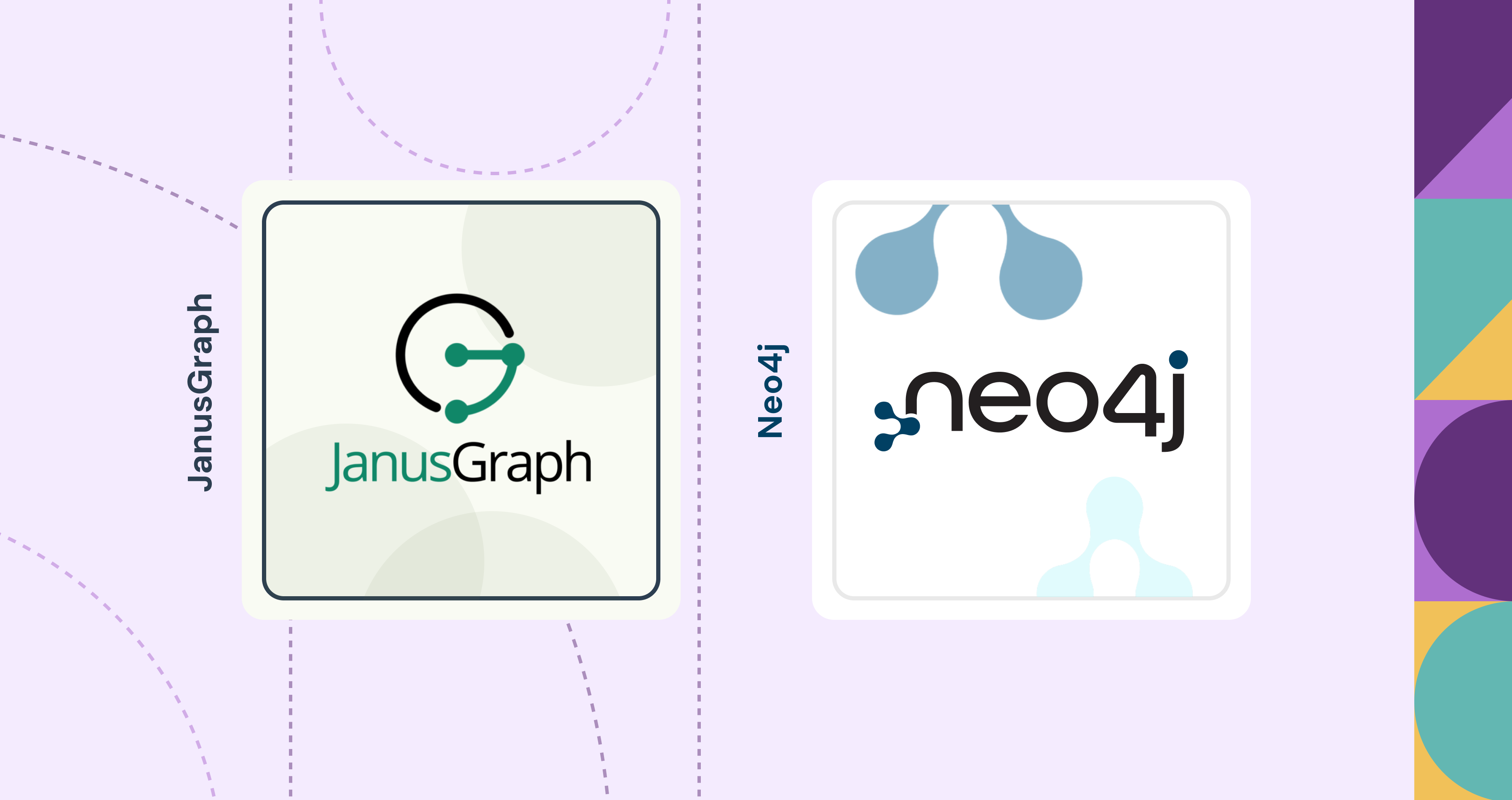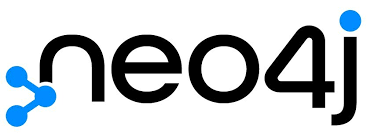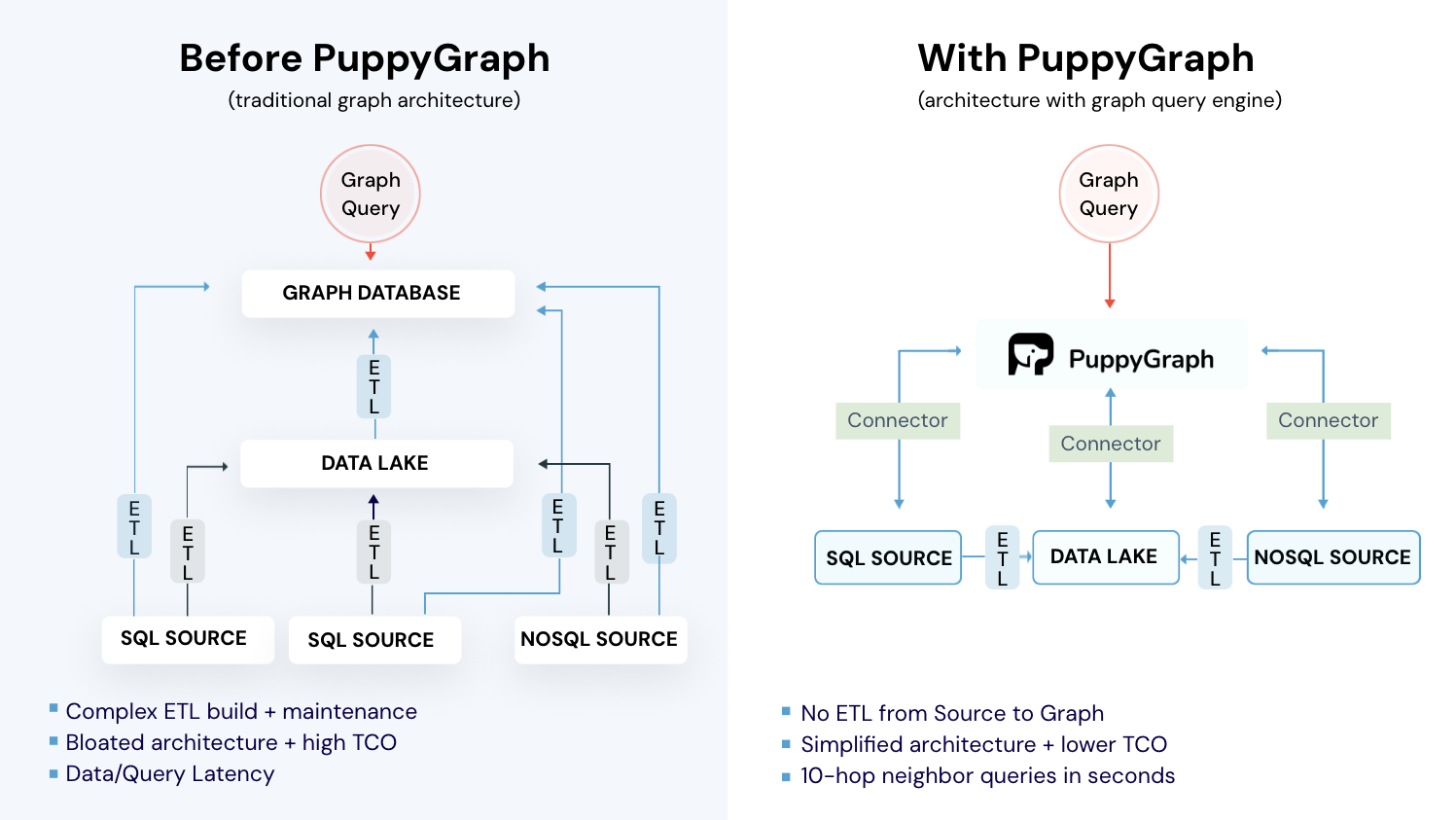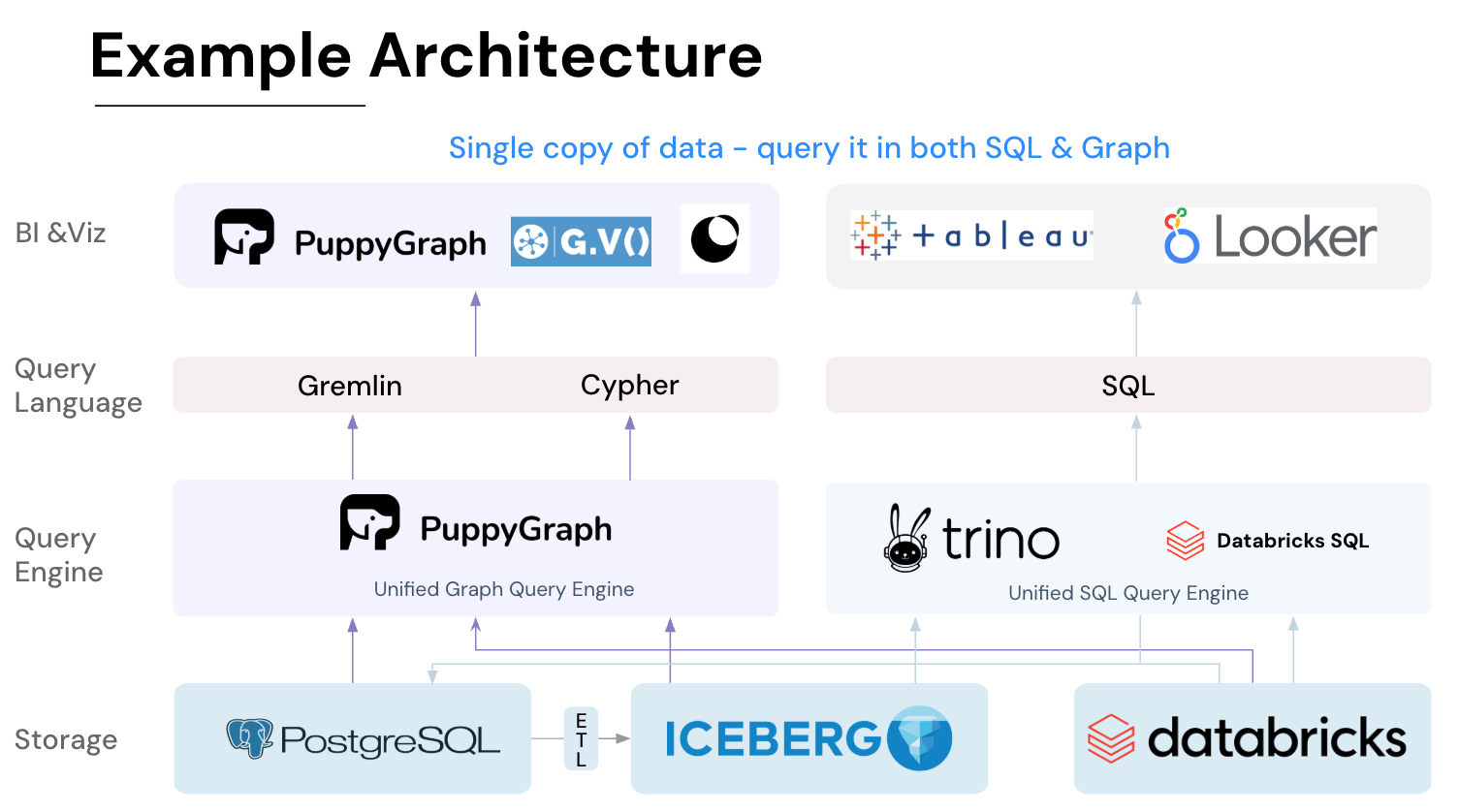Janusgraph vs Neo4j : Key Differences & Comparison

Graph databases are built for data where relationships matter as much as the entities themselves. They make it easier to analyze patterns, dependencies, and interactions that are difficult to capture in tables. Neo4j has long been recognized as the leading example of this approach. Its native property graph engine delivers fast traversals and consistent performance, while its query language, Cypher, provides a readable and expressive way to describe complex relationships.
JanusGraph, in contrast, follows a distributed architecture. It stores graph data across scalable backends such as Apache Cassandra, HBase, or ScyllaDB, and uses external indexing systems like Elasticsearch or Solr. It adopts the Apache TinkerPop framework and uses Gremlin as its query language, enabling flexible graph traversals over large, partitioned datasets. This design supports massive scale but often introduces greater setup and tuning complexity.
In this article, we compare Neo4j and JanusGraph in terms of design, scalability, and practical use cases. We also briefly highlight how PuppyGraph approaches graph querying differently, offering a simpler, zero-ETL way to explore connected data.
What is Neo4j?

Neo4j is a native graph database built on the principle of index-free adjacency, where relationships are stored as first-class data structures directly linked to nodes. Each node maintains references to its connected relationships, allowing traversals to operate in proportion to the number of relationships explored rather than the overall dataset size. In practice, performance still depends on graph structure, indexing, and query planning. Neo4j provides full ACID transactional guarantees and uses Cypher, a declarative graph query language for expressing pattern-based traversals.
Data Model and Query Semantics
Neo4j implements the property graph model:
- Nodes: Entities such as users, devices, or events
- Relationships: Directed, typed connections linking nodes
- Properties: Key-value pairs stored on both nodes and relationships
Neo4j’s declarative query language, Cypher, allows you to intuitively define graph patterns:
MATCH (a:User)-[:PURCHASED]->(b:Product)
WHERE a.country = "Canada"
RETURN a.name, b.titleNeo4j’s cost-based query planner selects traversal and indexing strategies automatically during execution planning. Effective performance, however, still relies on appropriate schema indexes and well-designed data models. Cypher supports subqueries, parameterized statements, and user-defined procedures implemented in Java or other JVM languages.
Operational Considerations
Neo4j's Causal Clustering architecture, offered in the Enterprise and Aura editions, ensures fault-tolerant replication through the Raft consensus protocol. Writes are reliably replicated, while reads can scale horizontally using read replicas. Bookmarks provide causal consistency, allowing clients to access their own writes in distributed environments. Enterprise editions also feature role-based access control (RBAC), multi-database management, and detailed security policies.
What is JanusGraph?

JanusGraph is a distributed, scalable graph database designed for large-scale analytics and transactional graph workloads. It acts as a graph abstraction layer on top of external storage and indexing systems rather than maintaining its own storage engine. Typical configurations pair it with:
- Storage backends: Apache Cassandra, ScyllaDB, HBase, Google Bigtable, or BerkeleyDB
- Index backends: Elasticsearch or Solr
This architecture enables JanusGraph to scale to billions of vertices and edges across clusters of commodity hardware. Its scalability and flexibility depend heavily on the capabilities and configurations of these underlying systems.
Data Model and Query Semantics
JanusGraph implements the property graph model similar to Neo4j:
- Vertices: Entities that hold labeled attributes
- Edges: Directed, typed relationships between vertices
- Properties: Key–value pairs attached to both vertices and edges
JanusGraph uses the Gremlin query language, part of the Apache TinkerPop framework. Gremlin is an imperative and traversal-based language that describes the process of walking through the graph rather than declaring what result to retrieve.
For example, this query retrieves all users followed by Alex:
g.V().hasLabel('user').has('name', 'Alex').out('follows').values('name')Gremlin provides flexibility for both OLTP (real-time transactional) and OLAP (analytical) traversals. Through TinkerPop’s integration with Spark or Hadoop, JanusGraph can execute large-scale analytical computations over distributed graph datasets; Neo4j typically relies on its Graph Data Science (GDS) library instead for the same feature.
Transactions and Consistency Model
JanusGraph provides ACID transactions at the graph layer, but actual enforcement depends on the storage backend. Backends like Cassandra offer tunable consistency with eventual consistency in some configurations. HBase provides strong consistency within a single region.
This means transactional guarantees vary by backend and consistency settings. Users can configure write durability using levels such as ONE, QUORUM, or ALL, trading throughput for reliability. This tunability offers flexibility but introduces more operational complexity than Neo4j’s unified transactional engine.
Operational and Deployment Characteristics
Because JanusGraph runs on top of existing distributed databases, it inherits both their scalability and their operational burden. Scaling a JanusGraph deployment involves scaling the underlying storage and indexing clusters independently. This makes it highly elastic, capable of storing graphs exceeding trillions of relationships, but also more complex to tune and monitor.
JanusGraph’s stateless graph servers allow multiple clients to connect concurrently through Gremlin Server or frameworks like Spring Data for JanusGraph. Deployment topologies range from single-node testing setups to multi-region clusters with separate storage and index tiers.
Security, authentication, and backup processes also depend on backend configuration. For example, Cassandra handles node-level encryption and access control, while Elasticsearch manages its own security layer; so you will need to coordinate across systems for consistent policies.
Neo4j vs JanusGraph: Feature Comparison
The following table provides a high-level comparative overview of these two vendors across different feature categories:
Neo4j vs JanusGraph: Architecture Comparison
Neo4j and JanusGraph both implement the property graph model but differ fundamentally in how they store, manage, and scale data. Neo4j follows a fully integrated, native design optimized for real-time traversal and consistency, whereas JanusGraph adopts a layered architecture that delegates storage and indexing to distributed backends. These choices affect scalability, fault tolerance, and operational complexity in distinct ways.
Storage Design
Neo4j stores nodes, relationships, and properties in a proprietary on-disk format built on index-free adjacency. Each relationship record points directly to connected nodes, enabling constant-time traversals. A transaction log ensures ACID durability, while the page cache holds frequently accessed data for faster reads. Performance depends on data modeling, indexing, and query planning.
JanusGraph relies on external backends such as Cassandra, ScyllaDB, HBase, or Bigtable. It represents vertices and edges as key–value tuples distributed by partitioning schemes. This layered design scales nearly linearly across commodity servers but ties latency and durability to backend replication, compaction, and I/O behavior.
Clustering and Fault Tolerance
Neo4j implements Causal Clustering based on the Raft protocol. One primary handles writes while secondaries replicate data and serve reads. Transactions commit once a majority of primaries acknowledge, maintaining consistency under failure. Leader election and causal bookmarks support predictable, fault-tolerant behavior.
JanusGraph inherits clustering and replication from its backend—Cassandra’s gossip protocol and tunable consistency levels (ONE, QUORUM, ALL) are common. The graph layer is stateless, with multiple Gremlin Servers processing traversals concurrently. Elastic scaling is achieved through backend replication, though fault tolerance depends entirely on backend configuration.
Indexing and Query Processing
Neo4j integrates schema and full-text indexes into its core engine. The Cypher planner uses a cost-based optimizer to select access paths and indexes, keeping execution tightly coupled with storage for low latency.
JanusGraph uses external systems such as Elasticsearch or Solr for indexing. These engines synchronize asynchronously with the graph and add overhead but enable rich full-text and geospatial queries across distributed data.
Consistency and Transactions
Neo4j delivers end-to-end ACID guarantees with deterministic consistency, even in clusters. Causal bookmarks ensure “read-your-own-write” semantics across replicas.
JanusGraph supports ACID at the graph layer but defers enforcement to the backend. With Cassandra, for example, writes may propagate asynchronously unless higher consistency levels are configured. This tunability improves scalability but requires careful setup to maintain correctness.
Operational Implications
Neo4j’s unified stack simplifies deployment, backups, and monitoring; behavior remains consistent across environments.
JanusGraph’s modular design offers near-unlimited horizontal scale but higher operational complexity. Teams must coordinate tuning, caching, and consistency across multiple systems, balancing flexibility against predictability.
Which Has Better Performance and Scalability?
Performance and scalability depend not only on architecture but also on how each system handles queries, transactions, and resource management in real workloads. Neo4j and JanusGraph follow different optimization paths, as one for tightly integrated low-latency traversal, the other for distributed scale and flexibility.
Query Performance and Latency
Neo4j delivers consistently low-latency query execution in OLTP scenarios. Its index-free adjacency enables direct pointer access for traversals, and the unified engine tightly integrates caching and storage. In typical enterprise workloads such as fraud detection, identity resolution, or real-time recommendations, traversals complete within sub-millisecond to low-millisecond latencies per hop when data is well modeled and indexed.
JanusGraph introduces coordination overhead between the graph layer and distributed storage backends. Each traversal step may involve multiple network reads depending on vertex partitioning. Latency is typically higher and less predictable, especially for traversals spanning partitions or relying on external indexes. However, when paired with Apache Spark through TinkerPop OLAP, JanusGraph can excel at large analytical traversals or batch computations where throughput matters more than latency. Recent benchmarks also show Neo4j’s parallel runtime achieving competitive results for large-scale analytics within its native engine.
Write and Update Throughput
Neo4j guarantees full ACID compliance, prioritizing durability and consistency over raw concurrency. In clustered deployments, each transaction is replicated via Raft and committed once a majority of primaries acknowledge it—typically adding tens of milliseconds of latency. This makes Neo4j well suited for write-consistent workloads where correctness outweighs peak throughput.
JanusGraph scales write throughput horizontally, limited mainly by the storage backend’s capacity and replication settings. In Cassandra or ScyllaDB clusters, writes can scale near-linearly with appropriate consistency levels and partition design. It fits ingestion-heavy use cases such as IoT or metadata graphs, though higher consistency levels increase latency and coordination overhead.
Scalability and Resource Utilization
Neo4j scales vertically and horizontally through Causal Clustering, where replicas serve reads in parallel without affecting writes. Write scalability is constrained by Raft’s quorum rule, favoring determinism over elasticity. Fabric supports federated queries across databases, and Infinigraph introduces sharding for single graphs beyond 100 TB, extending to petabyte-scale through federation in Enterprise deployments.
JanusGraph scales horizontally by design. Storage and index backends can grow independently across clusters, supporting graphs with billions of vertices and trillions of edges if infrastructure allows. This flexibility enables global-scale deployments but increases operational tuning for partitioning, compaction, and index synchronization.
Caching, Memory, and Hot Data Behavior
Neo4j uses an adaptive page cache to keep frequently accessed graph segments in memory, minimizing disk I/O and ensuring predictable performance for hot datasets. The cache is unified within the database and fully tunable.
JanusGraph depends on backend caches such as Cassandra’s row cache or HBase’s block cache. These are optimized for wide-column access, not graph traversals, so cache efficiency varies by data locality. Achieving low-latency access for hot sets may require memory-heavy nodes or external caching layers like Redis or Memcached.
Operational Performance and Cost
Neo4j’s integrated architecture simplifies tuning, scaling, and monitoring. With a single engine and predictable behavior, it delivers consistent latency and cost predictability especially in managed services like AuraDB.
JanusGraph’s performance reflects its multi-component design. Scaling often requires provisioning additional storage and indexing nodes. While this increases complexity, it enables independent scaling of compute, storage, and indexing resources, offering more elastic cost control at a very large scale.
When to Choose Neo4j vs JanusGraph
Now that their design and performance trade-offs are clear, let’s see which one fits better for you based on the workload.
When to Choose Neo4j
Choose Neo4j when you need fast, consistent graph queries with full ACID guarantees and predictable performance.
Neo4j’s native engine handles transactional and real-time workloads efficiently. It stores nodes and relationships as first-class structures, so traversal time depends on hop count rather than total graph size. It’s ideal for applications like fraud detection, recommendations, and identity resolution.
Deployment is straightforward. Storage, indexing, and clustering are integrated, and the managed AuraDB service automates scaling and backups. If your data fits on a few high-memory nodes and you want minimal operational complexity, Neo4j is the better choice. The Infinigraph architecture also extends Neo4j’s scalability for enterprise workloads.
When to Choose JanusGraph
Choose JanusGraph when you need to manage very large, distributed graphs or already use data platforms like Cassandra, ScyllaDB, or HBase.
JanusGraph builds on these systems to scale horizontally across clusters and regions. It works well for massive graphs, such as recommendation networks or cybersecurity data, where writes are continuous and distributed.
Its modular design lets you scale compute, storage, and indexing separately and tune each layer for cost or performance. However, running JanusGraph requires more setup and coordination across multiple backends. It fits teams with distributed-systems experience and existing big data infrastructure.
Why Consider PuppyGraph as an Alternative
Consider your data stored in a lakehouse. You want to query it as a graph. How can you do that? Instead of moving the data into a separate graph database, you can use PuppyGraph, which builds a graph layer directly on your relational data.

PuppyGraph is the first and only real time, zero-ETL graph query engine in the market, running directly on your existing relational and lakehouse tables. You keep data where it lives, then query it as a graph without ETL or a separate graph store. This closes gaps you hit with both Neo4j and JanusGraph on analytical, multi-hop work.
Instead of migrating data into a separate, specialized graph database, PuppyGraph connects to your existing data sources, including PostgreSQL, Apache Iceberg, Delta Lake, BigQuery, and more, and creates a virtual graph layer on top. Graph models are defined through simple JSON schema files, making it easy to update, version, or switch graph views without touching the underlying data.
This architecture separates computation from storage, enabling petabyte-level scalability and eliminating the data duplication, pipeline fragility, and maintenance headaches associated with traditional graph deployments.


Analytical traversals compile into set-based, vectorized plans on the underlying engine. Joins, filters, and expansions run close to the data with predicate pushdown and parallel scans. You avoid per-hop network calls to a wide-column store and an external index tier, which often makes PuppyGraph faster and steadier than JanusGraph for long paths. You also avoid exporting and reloading data into a separate Neo4j cluster just to run analysis.
When it comes to languages, PuppyGraph gives you the best of both worlds, supporting both Gremlin and openCypher. Neo4j teams can keep writing Cypher, and JanusGraph teams can keep writing Gremlin. Modeling user behavior becomes natural with pattern matching, path finding, and sequence grouping. These questions are awkward in SQL, but they map cleanly to graph queries.

As data grows more complex, the teams that win ask deeper questions faster. PuppyGraph fits that need. It powers cybersecurity use cases like attack path tracing and lateral movement, observability work like service dependency and blast-radius analysis, fraud scenarios like ring detection and shared-device checks, and GraphRAG pipelines that fetch neighborhoods, citations, and provenance. If you run interactive dashboards or APIs with complex multi-hop queries, PuppyGraph serves results in real time.
Getting started is quick. Most teams go from deploy to query in minutes. You can run PuppyGraph with Docker, AWS AMI, GCP Marketplace, or deploy it inside your VPC for full control.
Conclusion
Neo4j and JanusGraph represent two different paths for working with graph data. Neo4j offers a unified, native architecture that excels at transactional and real-time workloads, providing consistent performance and straightforward operations. JanusGraph, built on distributed backends, delivers the scale and flexibility needed for massive, multi-region graphs but at the cost of greater setup and coordination. Beyond traditional graph databases, PuppyGraph stands apart in the market as the only graph analytic engine that provides unified, enterprise-scale graph intelligence without sacrificing your current data stack. That means you can establish a graph system from your existing databases and data lakes, without any ETL or duplication.
To see how it all works, get started with PuppyGraph's forever free Developer edition. You can also book a free demo today to talk with our graph experts.
Get started with PuppyGraph!
Developer Edition
- Forever free
- Single noded
- Designed for proving your ideas
- Available via Docker install
Enterprise Edition
- 30-day free trial with full features
- Everything in developer edition & enterprise features
- Designed for production
- Available via AWS AMI & Docker install






